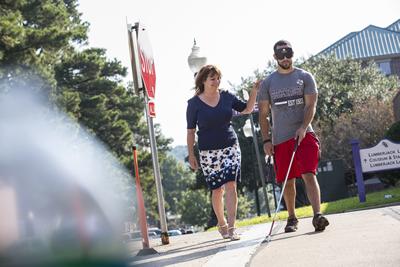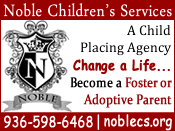 October 16, 2017 Nacogdoches — Stephen F. Austin State University is home to the only undergraduate orientation and mobility program in the country.
October 16, 2017 Nacogdoches — Stephen F. Austin State University is home to the only undergraduate orientation and mobility program in the country.
Since the program began in 1972, faculty and staff members have trained hundreds of students to assist people with visual impairments or who are blind.
“Even though there is a small percentage of the population who needs these services, it is a growing need, especially since the likelihood of having a visual impairment increases with age,” said Michael Munro, director of SFA’s orientation and mobility program.
As the program’s name suggests, orientation means knowing where one is in relation to the environment, and mobility is knowing how to get from point A to point B in a safe and efficient manner. Students are taught the difference between being visually impaired and blind as well as the different visual impairments and eye conditions and how these impairments affect people.
Assessment is key in this field as no person with a visual impairment is the same as another. Students in the program learn how to travel under blindfold so they can show other people who do not have full vision how to use a cane and allow them to become confident in their walking and travel skills in a variety of environments. Students also learn to become more in tune with their non-visual skills such as learning to interpret what they hear and feel to help them to know where they are.
Jennifer Perry, clinical instructor in the orientation and mobility program, helps debunk some of the program’s misconceptions.
“The students in our program are not training people to become blind, as some people who see us may think. Our students are learning to become highly trained specialists who will assist individuals and families if vision loss occurs in their lives,” Perry said. “This a growing field that many people do not consider as a career choice because many people either do not know someone who is blind, or they are unaware that the name of this training specialty is called orientation and mobility.”
A key component of the program is its cane training where students learn to use a cane and navigate an area while blindfolded to simulate complete blindness. Students in training often are observed around campus using canes while blindfolded.
“Being under a blindfold helps students train others and learn what it’s like not to rely on sight and puts the skills we have taught them into practice. It really is a transformational-learning experience,” Munro said. “It’s incredible to see the students grow from when they first come here to when they leave. They do things they never thought they could such as crossing a street blindfolded and navigating a bus without being able to see.”
At SFA, students can receive a Bachelor of Science in rehabilitation services with a concentration in orientation and mobility or a master’s degree in special education with a specialization in orientation and mobility.
Students who complete training at either the undergraduate or graduate level are eligible to become nationally certified by the Academy for Certification of Vision Rehabilitation and Education Professionals. Students engage in 120 observation hours and 350 internship hours at both the undergraduate and graduate levels.
For more information, contact Munro at (936) 468-1036 or munromicha@sfasu.edu
By Kasi Dickerson, senior marketing communications specialist at Stephen F. Austin State University.









